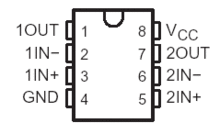


The LM358 is a low-power dual operational amplifier integrated circuit, originally introduced by National Semiconductor.[1]
It uses a single power supply from +3 to +30 volts for VCC (though some variants go higher, such as 36 volts for the LM358B).
Input voltage can range from −0.3 volts to VCC. Small negative input voltages below ground (GND) are acceptable because the bipolar junction transistors at the input stage are configured such that their base-emitter junction voltage provides just enough voltage differential between the collector and base for the transistors to function.[2]
History
[edit]After the development of the 741 and its dual and quad derivatives, National Semiconductor's Russell and Frederiksen developed an amplifier design suitable for low-voltage single supply packages,[3][4] hinging on an input stage gm reduction technique due to James Solomon.[5][4] This was developed into the LM324, which quickly became the industry standard quad op-amp.[4] The LM358 followed shortly, a similar dual design, joining a group of low cost, decades old industry standards.[4]
References
[edit]- ^ http://www.ti.com/product/lm358
- ^ Elliott, Rod (2016). "Voltage Followers". sound-au.com. Figure 5. Archived from the original on 2021-08-01. Retrieved 2022-07-27.
- ^ Ronald Russell, Thomas Frederiksen, “Automotive and Industrial Electronic Building Blocks,” IEEE Journal of Solid-State Circuits, Vol. SC-7, December 1972, pp. 446–454.
- ^ a b c d Op Amp Applications Handbook, Walt Jung, Editor, 2005, e Analog Devices Series, page 809 Oxford and Burlington, Newnes
- ^ James Solomon, “The Monolithic Operational Amplifier: A Tutorial Study,” IEEE Journal of Solid State Circuits, Vol. SC-9, No. 6, December 1974.
Further reading
[edit]The LM358 is now an industry-standard part manufactured by multiple companies, all of which publish datasheets:
- Diodes Incorporated: datasheet, webpage
- Fairchild Semiconductor: datasheet, webpage
- ON Semiconductor: datasheet, webpage
- ST Microelectronics: datasheet, webpage
- Texas Instruments: datasheet, webpage
- National Semiconductor: datasheet, supporting materials for MIT course 6.115.